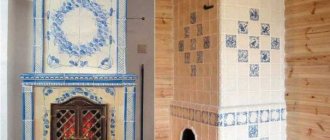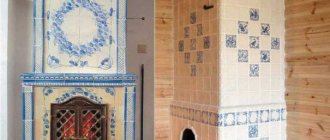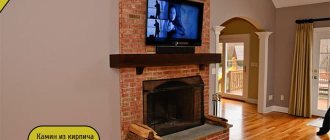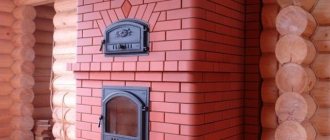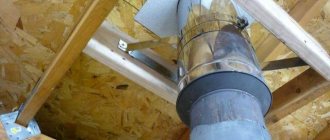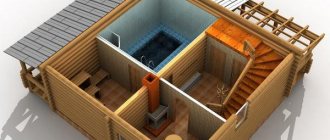The advent of modern heating devices has made it possible to increase the comfort of life in a country house and in the country. With the advent of new technologies, it would seem that ancient stoves should go into oblivion.
Swedish stove with stove and oven
However, today we can observe another trend.
Stone stoves are becoming increasingly popular, allowing you to heat your home and prepare a hearty meal for the whole family. Today we will tell you what a Swedish oven with oven and stove is. What are its technical features, operating principle, and how can you make this compact and efficient stove with your own hands?
A little bit of history
In our country, the Swedish stove is quite popular as a fairly efficient and economical heating design. It can be used both for heating the house and for cooking and heating water.
Swedish stove in a country house
In terms of performance, it is in no way inferior to the classic Russian stove, which from time immemorial has been used in our country for heating the house and cooking. But in terms of fuel efficiency and small dimensions, it can leave the Russian stove far behind.
Therefore, if you are now wondering what design to use to heat your home, pay attention to the technical details of this stove and carefully study its advantages.
As the name suggests, this stove model was invented in Sweden. Some sources indicate that the new masonry technology was brought by Peter I to Russia, while others claim that it was invented much later.
Swedish stone oven
One way or another, the Swede was designed by Swedish engineers in accordance with all the requirements and subtleties of the local climate. This model is very similar in design to a Dutch oven, but its main difference is the presence of a wall, which allows you to place the heating structure in two rooms at once.
Considering the cold and damp climate most of the year, the oven had to not only heat, but also dry clothes overnight, because in the morning hunters and fishermen, who were the majority of the local population, needed to start work again and, in order not to get sick, clothes should should be well dried and warmed up.
Another remarkable difference of the Swedish stove is the combination of two functions: heating the room and cooking. The large cooking surface allows you to prepare dinner for the whole family and heat water. And in the oven, which is usually equipped with a Swede, you can bake bread.
Swede between kitchen and living room
In addition, the unique shape of the firebox - in the form of a bell - allows you to burn fuel efficiently and maintain the smoldering of wood for a long time, which increases the efficiency of the stove.
A small Swedish stove with a hob and oven is designed to be placed in the wall between the kitchen and living room. This type of placement is traditionally used in the northern countries.
Due to this arrangement, the kitchen quickly warms up, it is convenient for the housewife to prepare food, and the residual heat that is generated for cooking effectively warms up the entire room. Thus, with one stack of firewood you solve two problems at once: the house will be both warm and satisfying.
Swede with a bed
In the old days, such stoves were equipped with additional sunbeds that protected them from the cold at night. Now in modern homes you can find small and compact Swedish stoves with an oven and hob, which are both a functional design and a stylish interior decoration.
Today on sale you can find a wide variety of Swedish stoves of various designs: with a water circuit, with an oven, with a hob.
Example of a Swedish oven with two ovens
Or you can build it with your own hands, having basic experience in laying a stove.
With your own hands
Next, we present to your attention the order of a Russian stove with a fireplace, with the help of which you can build a heating device in your home yourself.
Tools and materials
Construction of a Russian fireplace stove with an oven is not a difficult task. Even those who have not encountered this before can do it. Correctly selected tools, materials and parts play an important role. No less important is the implementation of all steps for laying the stove in the correct sequence.
In order to build a unit, you need to stock up on tools such as a tape measure, a shovel and a crowbar, as well as roofing felt. A torch, a grinder, a reinforcing rod 10 mm thick and a machine designed for welding will be useful.
To lay a fireplace stove, you need to purchase sand and chalk, solid refractory brick, M300 concrete and clay mortar. The parts you will need are a hob, a strip made of steel, doors, and an oven.
Foundation
The first stage in the construction of a heating fireplace stove is laying the foundation. If the base is poorly made, the stove will not last long. Using chalk, a square measuring 110x110 cm is drawn on the floor. The hole should be 35 cm deep. The walls need to be leveled with a shovel, and the bottom should be filled with a sand cushion 5 cm high. The structure needs to be covered with roofing felt, and the seams must be carefully soldered using a torch.
Next, five reinforcing rods are bent into rectangles. The dimensions of the latter should be 100x20 cm. The ends of each piece of wire must be welded together to form a single ring. The step between them should be 20 cm. Now additional rods with the same distance are installed on the finished frame. The resulting product is mounted in an already prepared hole.
Next, the solution is poured. It should be 5 cm below the floor level. When the structure dries (in about 20-25 days), it will be possible to continue building the stove.
Order
The main thing in laying a brick fireplace stove is the correct sequence of actions. The result is a fireplace stove as shown in the diagram:
Operating principle and design of the Swedish oven
The compact dimensions of the stove (1020x885x2030mm) allow it to be placed in a small country house or dacha. But despite its small size, these dimensions of a Swedish stove are enough to effectively heat a room of 30-35 square meters.
Depending on the type and type of Swede, the designs will vary. So, for example, to equip a Swede with a sunbed, it is necessary to equip horizontal channels with a winter/summer mode. Thanks to a special valve, which is installed in a straight vertical channel, it is possible to block the latter.
In winter, such a valve closes, and the heat moves in a large circle, warming up the entire stove along with the sunbed. And in the summer, the damper opens a direct outlet for warm air into a vertical pipe through which the gases escape outside. This makes it possible to use only the hob and oven without heating the room.
Swedish stove
The “Dutch” design was taken as the basis for the Swedish stove. This model was already very popular, but it did not allow for effective heating of the room, and the fuel consumption was too high.
Taking into account the harsh climate of Scandinavia, the developers improved the “Dutch” model and added a hob with an oven. Thus, elements were added not only for cooking, but also for heating water and drying clothes.
Whatever the design of the stove - with a sunbed, with an oven or just a stove - the principle of its operation will be the same: channel, like the “Dutch”.
Swedish: scheme
The metal oven is located on the side of the firebox and is designed to directly transfer heat into the room. But cooking and baking is not the main function of the oven.
After lighting the wood, it warms up in literally 5 minutes. The figure shows why the oven heats up so quickly.
Swedish design
Before going down, combustion products heat the oven in the top and sides. On the other hand, the stove is heated by the firebox. The stove warms up from the firebox, heating the room itself.
The upper part was originally designed for the purpose of drying clothes; it is heated by the stove and the ducts running behind it. The channels, going around the entire oven, go into vertical channels and transfer heat to things that are hung out to dry.
How the Swedish oven works
The design of the Swedish stove is the result of improved engineering. Unlike Russian and Dutch stoves, it has a more complex device with high efficiency. It has significantly greater thermal power and heat transfer.
If we take the same amount of material and fold the “Dutch”, we will get a power of 2500 kcal/hour, while the Swede will produce all 3500 kcal/hour. In this case, it will be enough to lay only 2 portions of firewood per day to keep the house warm.
Swedish woman in a modern interior
If in Scandinavia the Swedes were traditionally installed between the kitchen and the bedroom so that on a cold winter night it would warm the room, today in stylish and modern houses you can increasingly find a stone structure that stands between the living room and the kitchen.
At the same time, it performs a double function: it serves for cooking and is the main decorative decoration of the living room. On one side it can be equipped with an oven, and on the other with an open fireplace, decorated with an openwork forged damper.
Swede with fireplace
The high efficiency and efficiency of the stove is due to a complex smoke exhaust system, which allows rational use of the heat generated by burning wood. One of the undeniable advantages of the design is the ability to create winter and summer versions of the stove.
The fact is that each type has its own smoke path. This makes it possible to cook food in summer without heating the room.
Many summer residents are familiar with the situation when, at the beginning of the heating season, when lighting the stove, the room begins to smoke. There is also a separate smoke exhaust system, which allows you to effectively use the stove with different functions in both winter and summer.
Peculiarities
A characteristic feature of a Russian stove with a fireplace is the presence of five smoke circuits, which are located vertically and covered with a corresponding number of special hoods. They are necessary to “catch” those heated gases that move along the smoke circuits and push them towards the bricks. This ensures that heat is retained longer in the stone parts of the fireplace stove, which helps maintain high temperatures throughout the house.
You can put in the firebox at one time the amount of firewood that is enough to warm up the stone stove. Each valve installed in this heating device performs its own function.
The top one is designed to close the pipe when the wood burns out.
The lower one is a kind of “mode switch” for the Russian fireplace stove.
When the device begins to warm up, the bottom valve should be closed. It is opened only when the heat in the firebox rises. This is necessary to prevent smoke from entering the living space.
This model of heating device has proven itself to be excellent, heating the house together with the attic stove. It is this tandem that provides the best results, because both the floor of the house and the attic are heated at the same time, which allows for better and faster heating of the room. A fireplace stove is a good solution if the floor area of your home is up to 80 square meters. m, and the attic does not exceed 35 sq. m. By choosing a corner fireplace stove, you significantly save space in the room.
The main advantages of the Swedish
What is most attractive about the design of the Swedish stove is the efficiency of fuel combustion.
Thanks to a successful technical design, coal, firewood, reeds or small wood burns in the firebox, forming a large mass of thermal energy.
Unlike a traditional Russian stove, which takes a lot of time before it starts giving off heat, a Swedish stove heats up very quickly. Thanks to this, within 10-15 minutes after laying and lighting firewood, the room is filled with warmth.
Swedish: advantages
At the same time, it not only quickly warms up the room, but also retains heat. To do this, after the firewood has died down, it is necessary to close the valve tightly. Otherwise, all the heat that has accumulated in the oven will quickly come out.
Like the popular Dutch oven, the Swede is very compact and does not take up much space in the house, which is indispensable in small country houses where the location of a large Russian stove simply does not make sense.
In addition, the cooking hob and oven provide additional comfort and increase the functionality of the oven.
Advantages of a Swedish woman:
- compact dimensions;
- functionality (hob, oven, water heating, etc.);
- fuel efficiency;
- the ability to warm two rooms at the same time.
But, speaking about the advantages of the Swede, it would be unfair not to notice some of her shortcomings.
The design of the Swedish stove is very demanding in terms of the choice of material. If ordinary fireclay brick is suitable for creating a Russian stove, then you need to stock up on very high-quality materials, otherwise the efficiency of the heating apparatus will be greatly reduced.
In addition, the design of such a furnace is quite complex and requires certain knowledge and a very subtle, scrupulous approach. After installation and launch, it will be very difficult to eliminate your mistakes.
Types of Swedes
There are several popular types of Swedish oven.
- The stove in the form of a fireplace is designed in such a way that the hob opens into the kitchen, and the decorative part with the firebox and fireplace portal opens into the living room.
- Swedish, equipped with a sun lounger. This stove design is quite complex, but in winter it functions as a very cozy and warm bed.
- Swedish, equipped with a hob and oven. The back part of such a stove heats the room, and the functional front part is located in the kitchen.
The choice of stove design depends on the area of the room and the functional tasks that it must solve. If the stove is needed exclusively for cooking in the country and is not intended to heat the house in winter, then you can opt for a compact design.
Swede with one plate
If the stove is installed as the main heating device, then it is better to choose a model that can heat several rooms at once.
It should be said that the Swedish stove design is an ideal option for a small country house, in which the owners live not only in the summer.
Of course, it is also suitable for a small cottage. But the Swede gets damp quickly enough, which means it requires constant use. Otherwise, it will have to be dried for a long time each time before putting it into operation, and this significantly reduces its efficiency.
With regular use, such a stove, equipped with a comfortable hob and a functional oven, will become an indispensable household assistant and will give warmth and comfort to the house.
Basic design of stoves with an oven
A detailed guide to self-laying gives a complete description of the steps, down to the location of each brick. But for better quality work, each master must be theoretically aware of the purpose of the main elements of the furnace. In simple words, he must understand what he is doing. For this purpose, there are schematic diagrams or descriptions of the device.
Good to know: How stoves without a chimney are implemented in practice, what they are like
A fireplace stove with an oven is a combination of two devices in a single design.
- A fireplace differs from a stove in that its purpose focuses on the hearth, its appearance, visibility and ease of use. Heating qualities are given secondary attention. Hence the more primitive structure of the fireplace chimney.
- The purpose of the stove is to heat a room or an entire house. All technical features are aimed at converting the energy released during the combustion of solid fuel into useful heat as efficiently as possible. To do this, it is necessary to use certain materials, select the optimal dimensions of the firebox and chimney, arrange a chimney channel with the largest area, and provide the necessary draft for air circulation. All these tasks are implemented in the design of the furnace.
The idea of combining a fireplace with a stove is not new. It is successfully used in many proven models. The structure of the fireplace hearth differs from the firebox, but can be adapted, since the stove firebox is only supplemented with a grate.
Ready-to-use furnace system
The operation of the oven is ensured by the niche being surrounded by channels through which hot air passes. But in some designs, the temperature inside the oven increases from the immediate proximity to the firebox in which combustion occurs.
The design of the furnace can be considered in individual points:
- The firebox is made in the form of a chamber lined with fireclay bricks. If the design includes a hob, the fire chamber is zoned by a partition. Firstly, the top part of the flame has the highest temperature. Secondly, firewood or other fuel should not interfere with dishes placed on the stove with open views. Therefore, combustion occurs in one zone, and the flame, due to draft, is drawn into the second zone where the stove is located.
- There is an ash pan at the bottom of the stove, under the firebox. Its door acts as a blower. The draft directly depends on the amount of incoming air, so using the blower you can regulate the intensity of combustion. In stoves intended for heating, the fireboxes are usually closed. They are known to increase the efficiency of the device. But the function of the fireplace requires visibility, so the firebox door is made of transparent glass, resistant to high temperatures.
- The chimney, due to its complex structure, has several cleaning doors that allow the channel to be serviced in sections.
Good to know: Installation of a stove-fireplace for heating a house, installation requirements
General recommendations for choosing building materials
You should only take on the construction of a Swedish stove with your own hands if you already have at least some initial masonry experience. This is a rather complex design and should not be chosen as the first experiment.
If you have basic bricklaying skills and have already dealt with installing stoves, then our detailed step-by-step instructions will allow you to master this process. Follow the instructions exactly and build each row in accordance with the indicated diagram.
Do-it-yourself Swedish oven
As mentioned above, the Swedish oven requires a very careful and careful approach. Unlike a traditional Russian or Dutch oven, used brick is not suitable for it. The efficiency and productivity of the Swede directly depends on the quality of the material. It is better to take fireclay or red brick.
Important! It is unacceptable to use silicate or hollow bricks to build a furnace.
You should also pay attention to the choice of solution. To build a firebox, it is necessary to mix a solution of special fireclay clay, which can withstand high temperatures. The clay should be smooth and of medium fat content.
To check whether the kneading is done correctly, take a thin layer of clay and apply it to a vertical surface. It should not drain and the consistency should resemble thick sour cream. Under no circumstances should there be any lumps or unmixed solution in the mixture.
Ordinary clay is suitable for lining a heating structure. If you make a fuel ignition chamber out of it, it will crack and the integrity of the stove may be at risk.
Fireclay brick
Separately, it should be said about the foundation for a Swedish stove. Given its heavy weight, the base must be made strong. It takes at least three weeks for the concrete monolith to harden. If you hurry and start laying on a fresh, not completely hardened foundation, then the heavy weight may cause the stove to become deformed.
One of the weak points of the Swede is the fire door. If you take a budget door from a stamped sheet, it will quickly become loose and fail. Therefore, it is necessary to take a cast door with a mustache, which will need to be securely walled up during laying.
You can vary the size of the stove and oven within 5-10 cm, but the thickness of the oven is of great importance. If you cook the oven yourself, use steel, which does not conduct heat well. If you take thin roofing iron, then such an oven will cool down quickly.
Construction of a simple cooking oven
Laying out even a simple oven is painstaking work that requires care and attention. The masonry is carried out according to the scheme - order. Before starting work, study the drawings and prepare materials.
Let's look at a detailed description of the masonry of a stove measuring 102 by 63 centimeters and 70 centimeters high. The mass of the finished structure will be approximately 650 kg.
To build such a brick kitchen stove you will need:
- Red solid or stove brick – 175 pcs.;
- Fireclay clay – 3 buckets;
- Sand - 2 buckets;
- Sheet roofing steel (sheet for the slab 63 x 102 cm, for the firebox 70 x 50 cm);
- Construction felt – 1 kg;
- Angle No. 30 for strapping.
Furnace equipment:
- Grate 18 x 25 cm – 1 pc.;
- Firebox door 21 x 25 cm – 1 pc.;
- Blower and cleaning doors 14 x 13 cm – 2 pcs.;
- Cast iron two-burner stove 90 x 53 cm – 1 pc.;
- Oven 35 x 35 x 45 cm;
- Gate valve 13 x 13 cm – 1 pc.
A brick stove with a stove is installed on a fireproof layer of felt impregnated with a clay solution. A sheet of roofing steel is stuffed on top. This slab can be installed without a foundation.
Note! The masonry is done using clay-sand mortar. For strength, you can add 10% cement.
Useful tips for laying swedes
- During the entire laying process, try to monitor the thickness of the seam. It should be 5 mm.
Seam between firebox and masonry
- To prevent the brick from absorbing moisture from the mortar during laying, it is recommended to wet it before construction work. It is enough to dip it in water for at least 1 minute so that it absorbs a sufficient amount of moisture.
- Do not forget to check the vertical and horizontal evenness of the masonry. To do this, use a building level and a plumb line. Use corners to check the evenness of the corners of the oven.
- After laying the stove, wait 2 weeks until it dries well. If you build a stove in the summer, it will dry out naturally. In cold weather, use a fan.
- Any furnace master will tell you that the less metal in the furnace, the better.
Leave a gap between the seams
But for hanging masonry you cannot do without metal corners, because arched vaults are not suitable here (Swedish vaults are distinguished by their compactness). The only condition that must be observed is that you cannot do anything close to the iron or place the iron on bare brick. In all places where it is planned to join metal parts with brick, a layer of mortar of 5-6 mm should be laid.
- When laying the hob on a brick, it is necessary to lay a layer of clay mortar on it. This will protect the brick from heating.
Swedish stove
By following our detailed instructions, you will definitely be able to arrange the oven correctly. A useful video will help you clearly understand the masonry scheme.
General rules for laying a stove
- The width of joints in brickwork should be 3 mm.
- A brick oven with a stove is laid out with mandatory bandaging of the seams; the vertical seams of adjacent rows should not coincide.
- Masonry starts from the corners and goes to the middle of the walls.
- Horizontalness is checked with a level, and verticality with a plumb line every two rows.
- It is better to fasten the upper part of the firebox door using a steel strip (25 x 2 mm) - the wire quickly burns out.
Note! To check verticality, experienced stove-makers pull strings in the corners - the lower ends are inserted into the seams of the first row of masonry, the upper ends are tied to nails driven into the ceiling.
